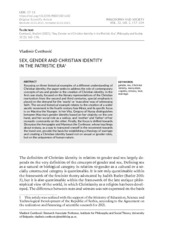Sex, Gender and Christian Identity in the Patristic Era
Pol, rod i hrišćanski identitet u patrističkom periodu
Чланак у часопису (Објављена верзија)
Метаподаци
Приказ свих података о документуАпстракт
Focusing on three historical examples of a different understanding of Christian identity, the paper seeks to address the role of contemporary concepts of sex and gender in the creation of Christian identity. In the first case study, focused on the literary representations of the Christian martyrdom from the second and third centuries, special emphasis is placed on the demand for the ‘manly’ or ‘masculine’ way of witnessing faith. The second historical example relates to the creation of a wider ascetic movement in the fourth-century Asia Minor, and its specific focus is on Macrina the Younger. In her Vita, Gregory of Nyssa distinguishes between Macrina’s gender identity based on her virginity on the one hand, and her social role as a widow, and ‘mother’ and ‘father’ of her monastic community on the other. Finally, the focus is shifted towards Dionysius the Areopagite and Maximus the Confessor, whose teachings about ecstasy, as a way to transcend oneself in the movement towards the loved... one, provide the basis for establishing a theology of marriage and creating a Christian identity based not on sexual or gender roles, but on the uniqueness of human nature.
Rad ima za cilj da pruži kratak pregled hrišćanskih pogleda na polni i rodni identitet, kako u ranohrišćanskom, tako i u patrističkom periodu. Fokusirajući se na tri istorijska primera ra-zličitog shvatanja hrišćanskog identiteta, rad nastoji da pokaže koju su ulogu igrali savremeni pojmovi pola i roda u stvaranju hrišćanskog identiteta u prvim vekovima hrišćanstva. U prvoj studiji slučaja, koja se odnosi na literarne prikaze mučeništva hrišćana u 2. i 3. veku, pozna-tijim kao martiriološka književnost, poseban akcenat se stavlja na zahtev za „muževnim“ sve-dočenjem vere. Drugi istorijski primer se odnosi na 4. vek i stvaranje šireg asketskog pokreta u Maloj Aziju, i posebno se fokusira na ulogu sv. Makrine Mlađe i način formiranja njenog rodnog identiteta kako na osnovu devstvenosti, tako i na osnovu njene uloge udovice, od-nosno majke i oca svojoj monaškoj obitelji. Na kraju, fokus se pomera prema Dionisiju Are-opagitu i sv. Maksimu Ispovedniku, čija učenje o ekstazi, kao izlasku iz ...sebe prema voljenom biću, daju osnova za uspostavljanje jedne teologije braka i stvaranju hrišćanskog identiteta ne na polnim ili rodnim ulogama, već na jedinstvenosti ljudske prirode.
Кључне речи:
gender / sex / Christian identity / martyrdom / virginity / ecstasy / love / marriageИзвор:
Filozofija i društvo/Philosophy and Society, 2021, 32, 2, 162-176Издавач:
- Beograd : Institut za filozofiju i društvenu teoriju
Финансирање / пројекти:
- Министарство науке, технолошког развоја и иновација Републике Србије, институционално финансирање - 200025 (Универзитет у Београду, Институт за филозофију и друштвену теорију) (RS-MESTD-inst-2020-200025)
Колекције
Институција/група
IFDTTY - JOUR AU - Cvetković, Vladimir PY - 2021 UR - http://rifdt.instifdt.bg.ac.rs/123456789/2245 AB - Focusing on three historical examples of a different understanding of Christian identity, the paper seeks to address the role of contemporary concepts of sex and gender in the creation of Christian identity. In the first case study, focused on the literary representations of the Christian martyrdom from the second and third centuries, special emphasis is placed on the demand for the ‘manly’ or ‘masculine’ way of witnessing faith. The second historical example relates to the creation of a wider ascetic movement in the fourth-century Asia Minor, and its specific focus is on Macrina the Younger. In her Vita, Gregory of Nyssa distinguishes between Macrina’s gender identity based on her virginity on the one hand, and her social role as a widow, and ‘mother’ and ‘father’ of her monastic community on the other. Finally, the focus is shifted towards Dionysius the Areopagite and Maximus the Confessor, whose teachings about ecstasy, as a way to transcend oneself in the movement towards the loved one, provide the basis for establishing a theology of marriage and creating a Christian identity based not on sexual or gender roles, but on the uniqueness of human nature. AB - Rad ima za cilj da pruži kratak pregled hrišćanskih pogleda na polni i rodni identitet, kako u ranohrišćanskom, tako i u patrističkom periodu. Fokusirajući se na tri istorijska primera ra-zličitog shvatanja hrišćanskog identiteta, rad nastoji da pokaže koju su ulogu igrali savremeni pojmovi pola i roda u stvaranju hrišćanskog identiteta u prvim vekovima hrišćanstva. U prvoj studiji slučaja, koja se odnosi na literarne prikaze mučeništva hrišćana u 2. i 3. veku, pozna-tijim kao martiriološka književnost, poseban akcenat se stavlja na zahtev za „muževnim“ sve-dočenjem vere. Drugi istorijski primer se odnosi na 4. vek i stvaranje šireg asketskog pokreta u Maloj Aziju, i posebno se fokusira na ulogu sv. Makrine Mlađe i način formiranja njenog rodnog identiteta kako na osnovu devstvenosti, tako i na osnovu njene uloge udovice, od-nosno majke i oca svojoj monaškoj obitelji. Na kraju, fokus se pomera prema Dionisiju Are-opagitu i sv. Maksimu Ispovedniku, čija učenje o ekstazi, kao izlasku iz sebe prema voljenom biću, daju osnova za uspostavljanje jedne teologije braka i stvaranju hrišćanskog identiteta ne na polnim ili rodnim ulogama, već na jedinstvenosti ljudske prirode. PB - Beograd : Institut za filozofiju i društvenu teoriju T2 - Filozofija i društvo/Philosophy and Society T1 - Sex, Gender and Christian Identity in the Patristic Era T1 - Pol, rod i hrišćanski identitet u patrističkom periodu IS - 2 VL - 32 SP - 162 EP - 176 DO - 10.2298/FID2102162C ER -
@article{
author = "Cvetković, Vladimir",
year = "2021",
abstract = "Focusing on three historical examples of a different understanding of Christian identity, the paper seeks to address the role of contemporary concepts of sex and gender in the creation of Christian identity. In the first case study, focused on the literary representations of the Christian martyrdom from the second and third centuries, special emphasis is placed on the demand for the ‘manly’ or ‘masculine’ way of witnessing faith. The second historical example relates to the creation of a wider ascetic movement in the fourth-century Asia Minor, and its specific focus is on Macrina the Younger. In her Vita, Gregory of Nyssa distinguishes between Macrina’s gender identity based on her virginity on the one hand, and her social role as a widow, and ‘mother’ and ‘father’ of her monastic community on the other. Finally, the focus is shifted towards Dionysius the Areopagite and Maximus the Confessor, whose teachings about ecstasy, as a way to transcend oneself in the movement towards the loved one, provide the basis for establishing a theology of marriage and creating a Christian identity based not on sexual or gender roles, but on the uniqueness of human nature., Rad ima za cilj da pruži kratak pregled hrišćanskih pogleda na polni i rodni identitet, kako u ranohrišćanskom, tako i u patrističkom periodu. Fokusirajući se na tri istorijska primera ra-zličitog shvatanja hrišćanskog identiteta, rad nastoji da pokaže koju su ulogu igrali savremeni pojmovi pola i roda u stvaranju hrišćanskog identiteta u prvim vekovima hrišćanstva. U prvoj studiji slučaja, koja se odnosi na literarne prikaze mučeništva hrišćana u 2. i 3. veku, pozna-tijim kao martiriološka književnost, poseban akcenat se stavlja na zahtev za „muževnim“ sve-dočenjem vere. Drugi istorijski primer se odnosi na 4. vek i stvaranje šireg asketskog pokreta u Maloj Aziju, i posebno se fokusira na ulogu sv. Makrine Mlađe i način formiranja njenog rodnog identiteta kako na osnovu devstvenosti, tako i na osnovu njene uloge udovice, od-nosno majke i oca svojoj monaškoj obitelji. Na kraju, fokus se pomera prema Dionisiju Are-opagitu i sv. Maksimu Ispovedniku, čija učenje o ekstazi, kao izlasku iz sebe prema voljenom biću, daju osnova za uspostavljanje jedne teologije braka i stvaranju hrišćanskog identiteta ne na polnim ili rodnim ulogama, već na jedinstvenosti ljudske prirode.",
publisher = "Beograd : Institut za filozofiju i društvenu teoriju",
journal = "Filozofija i društvo/Philosophy and Society",
title = "Sex, Gender and Christian Identity in the Patristic Era, Pol, rod i hrišćanski identitet u patrističkom periodu",
number = "2",
volume = "32",
pages = "162-176",
doi = "10.2298/FID2102162C"
}
Cvetković, V.. (2021). Sex, Gender and Christian Identity in the Patristic Era. in Filozofija i društvo/Philosophy and Society Beograd : Institut za filozofiju i društvenu teoriju., 32(2), 162-176. https://doi.org/10.2298/FID2102162C
Cvetković V. Sex, Gender and Christian Identity in the Patristic Era. in Filozofija i društvo/Philosophy and Society. 2021;32(2):162-176. doi:10.2298/FID2102162C .
Cvetković, Vladimir, "Sex, Gender and Christian Identity in the Patristic Era" in Filozofija i društvo/Philosophy and Society, 32, no. 2 (2021):162-176, https://doi.org/10.2298/FID2102162C . .



